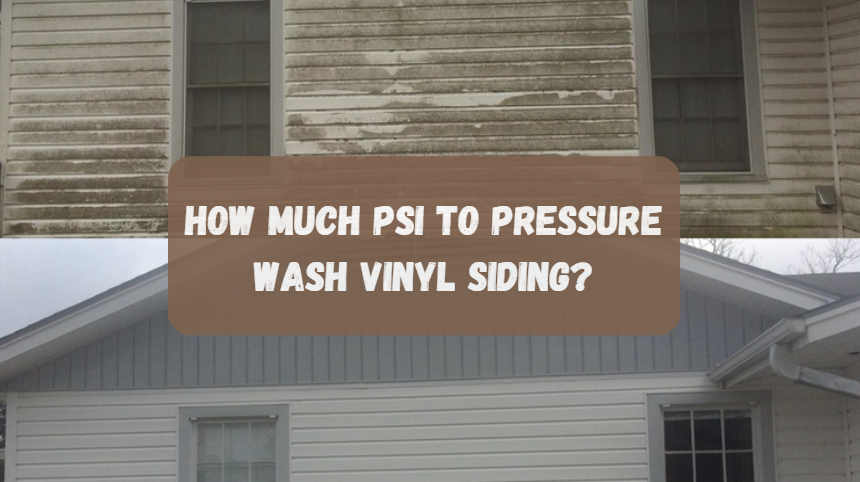Table of Contents
How much psi to pressure wash vinyl siding?
Recommended PSI for Vinyl Siding
For vinyl siding (such as typical home exterior panels), pressure-washing safely means staying in a moderate pressure range and using the correct nozzle and distance. Some key guidance:
- One professional cleaning outfit recommends using a washer set between 1,300–1,500 PSI for vinyl siding so you clean effectively without damage.
- Another guide says vinyl siding is safe with a PSI between 1,300 and 1,600 PSI, with a wide-angle nozzle (25° or 40°).
- Some sources suggest you can go up to ~2,000 PSI for vinyl siding, but only with caution.
- A contrasting viewpoint: when doing a “soft wash” (gentler cleaning method), pressures might be very low (60-150 PSI) because you’re relying more on detergents than pure force.
- One major home-improvement guide says vinyl siding “can withstand a powerful gas pressure washer (2,500-3,000 psi)”.
- However: That seems like an upper bound under ideal conditions—not something to aim for without experience.
- Many experienced DIYers advise: instead of focusing on the maximum pressure the siding can “take”, focus on the lowest pressure that cleans effectively, staying back some distance from the surface and using a fan (wide) nozzle.
My Recommendation
For most homeowner jobs: aim for 1,200-1,600 PSI, with a 25° or 40° wide-spray nozzle, keep your distance (12-24 inches or more), and test in a less visible area first.
If the siding is heavily soiled you might carefully go up toward ~2,000 PSI, but only if you’re confident in your setup and technique.

🛠 Step-by-Step Guide
Here’s how to do it properly and safely:
1. Gather equipment & prep
- Pressure washer with adjustable PSI setting (or choose a machine rated in the safe range).
- Wide spray nozzle (25° or 40°) — the wider the angle, the less concentrated force.
- Detergent or siding-safe cleaning solution (especially if there’s mold, mildew, or heavy dirt). For vinyl, a dedicated siding cleaner is smart.
- Safety gear: goggles, gloves, non-slip shoes. Cover nearby plants/shrubs, close windows/doors, protect electrical outlets.
2. Pre-clean and apply detergent
- Use a broom or brush to remove loose dirt, debris, cobwebs.
- Apply detergent/cleaning solution if needed: for example, mix water + mild soap or siding-safe cleaner. Let it dwell on surface for a few minutes (but don’t let it fully dry).
- Note: If you have mold/mildew, treat those spots with an appropriate solution before high-pressure rinse.
3. Rinse / wash the siding
- Set your pressure washer to your chosen PSI (e.g., ~1,300-1,500 PSI).
- Use the wide nozzle, hold the spray at a downward angle (to avoid forcing water behind the siding). Also maintain a safe distance (e.g., start ~12-24 inches away).
- Move nozzle steadily, don’t linger in one spot. Over‐spraying one area increases risk of damage.
- Work from top to bottom (or bottom to top depending on detergent application) to avoid streaking and ensure full rinse. Many guides recommend top to bottom for rinse.
4. Inspect & touch up
- After rinsing, check for missed stains or remaining dirt. For stubborn areas use a soft brush rather than cranking up pressure.
- Ensure no water was forced behind the siding panels (which could cause mold/rot). Avoid spraying upward into seams.
- Let the siding dry thoroughly.
5. Maintain & schedule
- Many sources recommend cleaning vinyl siding once per year (or more often if you live in a heavily wooded, damp, or shaded area).
- Keep an eye on color fade, chalkiness (vinyl eventually weathers), and areas where mildew may return.
⚠️ What to Watch Out For (Review / Risks)
Even when following best practices, there are risks with pressure-washing vinyl siding. Here’s a review of common issues and how to avoid them:
- Too much PSI / too narrow nozzle: A very high pressure or a concentrated spray can crack or dent vinyl siding, force water behind seams, strip paint (if painted), or warp panels.
- Improper angle / too close: If you hold the spray too close or angle upward into seams, water can get behind siding and cause moisture problems.
- Wrong nozzle: Using a narrow “pencil” spray tip (e.g., 0° or 15°) will concentrate force and increase risk. Always choose a fan-type (25° or 40°) for siding.
- Older or weakened siding: If your vinyl is old, brittle (especially in cold weather), or has previous damage, you may need to reduce pressure further or use a “soft wash” approach.
- Environment/temperature: Washing when it’s very cold, or when siding is under stress (heat, direct sun), can increase risk of damage.
- Vegetation, windows, electricals: Plants nearby can be harmed by cleaning solutions; windows and outlets need protection.
- Improper cleaning agent: Using harsh chemicals or bleach without rinsing properly can damage siding or cause discoloration.

Summary Table
| Task | Recommended Pressure / Tip |
|---|---|
| General cleaning vinyl siding | ~1,200-1,600 PSI with wide 25°/40° nozzle |
| Tougher stains (but still caution) | Up to ~2,000 PSI max — only if necessary & safe |
| Soft wash alternative (gentle) | ~60-150 PSI + detergent/chemical cleaning (less pressure) |
| Nozzle angle | 25°–40° fan spray; hold spray level/downward |
| Distance from surface | Start ~12-24 inches and adjust based on cleaning result |
| Direction of spray | Preferably from top to bottom for rinse; apply detergent bottom-up if specified |
READ ALSO: Garden hose pressure booster: Pros and Cons
FAQs
Can I use a 3,000 PSI pressure washer on vinyl siding?
Technically, yes — but it’s risky.
A 3,000 PSI washer is designed for concrete, decks, and driveways. On vinyl siding, that much pressure can:
Force water behind panels
Crack or warp the plastic
Strip paint or coating
If you use a 3,000 PSI machine, dial it down to a low setting or use a wide 40° nozzle to spread the pressure.
What nozzle should I use for vinyl siding?
Use a 25° or 40° fan-tip nozzle.
These produce a wide spray that cleans efficiently without concentrating the pressure in one spot.
Never use a 0° or 15° nozzle — those can easily gouge or crack siding.
How far should I hold the wand from the siding?
Keep the nozzle 12–24 inches away from the surface.
Start farther back and move closer only if needed.
Holding the wand too close increases the risk of damaging the siding or pushing water behind panels.
Should I spray from the bottom up or top down?
When applying detergent, start bottom-up so the cleaner doesn’t streak.
When rinsing, go top-down to wash away dirt evenly.
Always spray at a downward angle to avoid forcing water behind the vinyl.
What happens if I use too much PSI?
Excess pressure can cause:
Warping of panels (especially in hot weather)
Cracks or dents in brittle or old vinyl
Water infiltration leading to mold behind siding
Stripped paint if the siding has a painted finish

